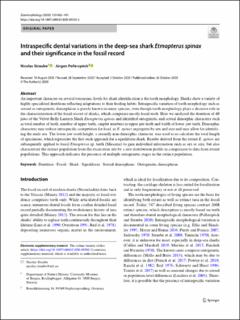| dc.contributor.author | Straube, Nicolas | |
| dc.contributor.author | Pollerspöck, Jürgen | |
| dc.date.accessioned | 2021-07-14T12:30:15Z | |
| dc.date.available | 2021-07-14T12:30:15Z | |
| dc.date.created | 2020-11-10T10:49:59Z | |
| dc.date.issued | 2020 | |
| dc.identifier.issn | 0720-213X | |
| dc.identifier.uri | https://hdl.handle.net/11250/2764427 | |
| dc.description.abstract | An important character on several taxonomic levels for shark identification is the tooth morphology. Sharks show a variety of highly specialized dentitions reflecting adaptations to their feeding habits. Intraspecific variation of tooth morphology such as sexual or ontogenetic dimorphism is poorly known in many species, even though tooth morphology plays a decisive role in the characterization of the fossil record of sharks, which comprises mostly fossil teeth. Here we analyzed the dentition of 40 jaws of the Velvet Belly Lantern Shark Etmopterus spinax and identified ontogenetic and sexual dimorphic characters such as total number of teeth, number of upper teeth, cusplet numbers in upper jaw teeth and width of lower jaw teeth. Dimorphic characters may reduce intraspecific competition for food, as E. spinax segregates by sex and size and may allow for identifying the male sex. The lower jaw tooth height, a sexually non-dimorphic character, was used to re-calculate the total length of specimens, which represents the first such approach for a squaliform shark. Results derived from the extant E. spinax are subsequently applied to fossil Etmopterus sp. teeth (Miocene) to gain individual information such as sex or size, but also characterize the extinct population from the excavation site by a size distribution profile in comparison to data from extant populations. This approach indicates the presence of multiple ontogenetic stages in the extinct population. | en_US |
| dc.language.iso | eng | en_US |
| dc.publisher | Springer | en_US |
| dc.rights | Navngivelse 4.0 Internasjonal | * |
| dc.rights.uri | http://creativecommons.org/licenses/by/4.0/deed.no | * |
| dc.title | Intraspecific dental variations in the deep-sea shark Etmopterus spinax and their significance in the fossil record | en_US |
| dc.type | Journal article | en_US |
| dc.type | Peer reviewed | en_US |
| dc.description.version | publishedVersion | en_US |
| dc.rights.holder | Copyright the authors 2020 | en_US |
| cristin.ispublished | true | |
| cristin.fulltext | original | |
| cristin.fulltext | original | |
| cristin.qualitycode | 1 | |
| dc.identifier.doi | 10.1007/s00435-020-00503-3 | |
| dc.identifier.cristin | 1846469 | |
| dc.source.journal | Zoomorphology | en_US |
| dc.source.pagenumber | 483-491 | en_US |
| dc.identifier.citation | Zoomorphology. 2020, 139, 483-491. | en_US |
| dc.source.volume | 139 | en_US |

